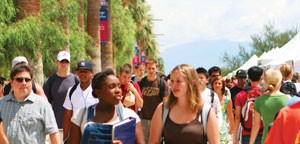Record-setting freshman enrollment for the fall semester has led to a larger student body and a more congested campus, leaving students and faculty to handle the ups and downs.
“”The university will grow slowly,”” said President Robert Shelton. “”We do hire new tenure, and tenure eligible faculty each year. However, the limits of our state budget mean that we also rely on growth in number of lecturers.””
Issues such as university identity, academic integrity and overcrowding have become contentious issues among students who must deal with increased student body size directly.
“”I think the increased amount of students is going to be both good and bad,”” said Rafael Garcia, a psychology senior. “”By incorporating more people into the student body we are getting more diversity and more differences of opinion, but if the campus size is not increasing at a similar rate, it is going to cause serious overcrowding.””
Apart from students, faculty and staff must deal with increased campus size on a longer term. As the growth continues, many faculty members will feel its effect in a way that graduate and undergraduate students will not.
“”The best learning takes place in a small environment,”” said Julia Clancy-Smith, associate professor of history. “”Fourtystudents is the limit to be able to analyze how they’re writing, which is ultimately about how they’re thinking. As the university gets bigger, we’re seeing increasing numbers but decreasing resources.””
Expressing similar sentiments is associate professor of history Linda Darling: “”If our enrollment grows, our superstructure has to go along with it. Our aspirational peers – what we call the universities that we would like to be our peers – did not get to where they are by skimping on resources, or by overloading their faculty and staff.””
However, not all faculty perceive growth negatively. Economics lecturer Alexandre Sugiyama believes that there are several advantages to having a larger campus.
“”We live in a state that has a growing population,”” Sugiyama said. “”It would make sense to ask state universities to expand to meet population needs, rather than funding a new institute. One of the advantages of having more students is potentially having more degree programs, or even more clubs, which many students would like.””
For students, overcrowding and campus growth are issues that are both pertinent and immediate.
“”There are a ridiculous amount of students on campus here,”” said Sonya Wool, sociology senior sociology and transfer student from Denver University. “”I can’t get over it. Every time I go out onto the mall during the day, I’m afraid that I am going to hit, or get hit, by someone. It’s pretty intimidating.””
In addition to overcrowding, the increased student body size raises questions among students regarding academic integrity and university identity. Shelton maintains, however, that the university has a distinct profile separate from sister schools ASU and NAU, and that academic quality is the university’s number one factor.
“”The three Regents’ universities NAU, ASU and the UA have distinct profiles, characteristics and missions,”” Shelton said. “”They afford a wide range of educational opportunities to the people of Arizona … at the UA, we ensure that the quality of education remains high.””
Not all students see the distinction so clearly.
“”I went to ASU for a semester,”” Garcia said. “”And I can tell you the UA is on its way. I think it’s still several years out, but if growth doesn’t get nipped in the butt soon, it will be like we are all walking around in Tempe.””
Feeling similar is linguistics and computer sciences senior, Kylen Knapp.
“”To really encourage a student to take their academics seriously, we need smaller class sizes than we already have,”” said Knapp. “”We need 20 or less students per classroom, where students can feel that their teacher actually knows them by name.””
Like faculty, not all students feel that increased student body size directly correlates to a loss of integrity or identity.
“”I like the size,”” said Leslie Walczak, an economics sophomore economics. “”I’m from out of state and it’s kind of hard to meet people, but at least here there is enough people. With big classes you have more students to talk to and more students to work with. Do I think there are students here that shouldn’t be? Yeah, there’s a lot of kids that don’t take college seriously, but I don’t think that’s because of its size.””
Shelton asserts that the university’s research program offers unparalleled opportunities for students and that the university’s identity will remain distinct.
For Shelton, increased campus size seems according to plan, but for Clancy-Smith it is not as clear.
“”If you want critical thinkers, good writers, good citizens, you’re not going to get them coming out of classes with 200 students.””
– Nickolas Seibel contributed to this story.









